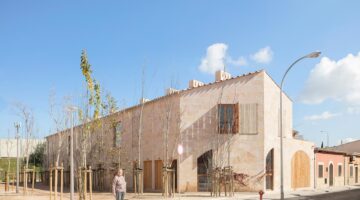

Salvador Espriu, 37, Palma (Mallorca)
Main objectives of the project
The public housing project in Palma (Mallorca, Spain), led by IBAVI, stands out for its careful integration of Mallorcan building and social traditions. From the use of local materials such as marés stone (sandstone) to the design of spaces that encourage outdoor community interaction, the project reflects a commitment to the preservation of the region's cultural and architectural identity. It also seeks to revitalise traditional social practices, such as the enjoyment of summer evenings outdoors, promoting a lifestyle that respects and celebrates local customs.
Date
- 2022: Construction
Stakeholders
- Promotor: IBAVI
Location
City: Palma de Mallorca
Country/Region: Palma de Mallorca, Spain
Description
The public works project, led by IBAVI, the public social housing agency in Mallorca, is located in a strategic point in Palma. Located next to the motorway belt that surrounds the city, this construction stands out as one of the last in the urban outline. In an area where low-rise single-family homes predominate, this project stands out for its boldness both in the number of housing units and in the quality of both construction and design.
The building is divided into two volumes, forming an L-shaped layout, one facing east-west and the other north-south. The two- and three-bedroom units are designed with dual orientation and employ a 20 cm thick “marés” stone (or sandstone, it is a type of stone formed by marine sand that was compressed during the Quaternary, typical of Mallorca’s buildings) period load-bearing wall structure. These walls provide thermal inertia for passive cooling, taking advantage of the cross ventilation of the sea breezes, known as the Embat de Mallorca. Unlike other public developments, such as the building in phase 1 at Salvador Espriu 18, a few blocks further down, where the buildable depth is 8 m and is resolved with stone vaults supported on the façade, in phase 2, with a buildable depth of 13.5 m, the façade is freed from its structural function to maximise the entry of natural light into the dwellings.
The timber floor slabs are supported on the party walls built with 20x20x80 cm sandstone blocks. To comply with the regulations on the maximum weight that can be handled by the operators, the marés pieces are cut in half. The structural solution is based on the Menorcan system, which has its roots in the Catalan system imported in the 13th century, while the Mallorcan system, derived from the Roman house, loads the floor slabs on the façade walls. The windows facing the public road are protected by a colonnade formed by 40x40 cm stone pillars, creating a loggia which houses roller shutters, grilles and planters with vines to provide shade and privacy for the porches and terraces.
The joint design of the buildings and public space aims to encourage residents to come out and enjoy the fresh air on summer evenings, reviving the Mallorcan tradition of sharing in the street as a communal space in hot weather. From the use of materials to the social intentionality behind the design, this project exemplifies the recovery of the Mediterranean city model, dense, compact and with public spaces that mitigate the ‘heat island’ effect. Recognised with the ‘Ciutat de Palma Guillem Sagrera’ prize for Architecture in 2022, this project illustrates how the efforts of the public administration can result in large housing developments that respect the traditions and building materials typical of the area.

